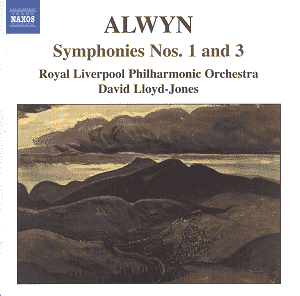Alwyn
Web-Site
After a pause of more
than six months Naxos have issued the
remaining two discs to complete Alwyn’s
mighty handful of symphonies for the
first time at bargain price. They enter
into competition of sorts with the composer’s
own cycle on Lyrita and Hickox’s on
Chandos. I say ‘of sorts’ because Hickox
is there in a single set (minus the
blessed Lyra Angelica) at mid-price.
The composer’s own 1970s analogue recordings
are still at full price.
The first Naxos-RLPO-David Lloyd-Jones
disc (symphonies 2 and 5) was reviewed
several times here at:-
http://www.musicweb-international.com/classrev/2005/Sep05/alwyn_symphonies25DB_8557647.htm
http://www.musicweb-international.com/classrev/2005/Oct05/Alwyn_2_5_8557647.htm
http://www.musicweb-international.com//classrev/2005/Aug05/Alwyn_2-5-lyra_8557647.htm
The First Symphony
always struck me as the most ‘filmic’
of the five. It has a certain heroic-romantic
mood and after the last two is my favourite.
This Liverpool recording has superb
stereo separation and a good natural
ambience which nicely complements the
yearning wistfulness of the writing.
Typical of the cinematic moments - comparable
with the sunset and decay in the finale
of Arnold 5 and for that matter Bax
5 - is the triumphant sunburst at 8:32.
The French horns call out their acclamation
to the days end. Quite magnificent!
The second movement echoes the con
malizia of Walton 1. It is extremely
exciting with channel breadth accentuating
the skitter and scamper of the music.
This is optimistic and exuberant writing
the bark and bite of which is extraordinary.
The downside is that yearning sigh of
this music is sold short; just too hurried
at 1.28 onwards. The composer and Hickox
allow more air and light. That said
there is a lovely silky quality to the
heart’s-ease strings at 6.21. This is
the movement to play to non-believers.
The third movement
is an adagio in which contented bells
are pastorally evoked. The mood is comparable
to his Autumn Legend. There is
even a touching cor anglais song.
At 5.23 the left-right ‘stretch’ is
wonderful. The finale is rowdily celebratory
with allusive echoes from far and wide.
At one moment the propulsion recalls
the punched out opening of George Lloyd’s
symphony No. 6 written at about the
same time. Then again the music suggests
links with the Easter Fair music
from Petrushka. Bax’s Fifth Symphony
may also have been in the composer’s
mind. Those who cannot hear the vitality
of Elgar’s Second Symphony (1:10) in
this movement had better listen to the
Elgar again. There are some moments,
it is true, where the movement sinks
into generalised doldrums but David
Lloyd-Jones delivers splendid bursts
of action: e.g. 9.24 onwards. At the
close, after a Beethovenian squall (9.56),
there is a telling reference back to
the yearning theme from the first movement
(10.03).
The Third Symphony
was the first to be recorded back
in the days of the LP. I found it emotionally
opaque then although impressions are
a little more favourable now. The music
marches in, heavy with threat like a
raider cleaving though coastal waters.
The music seethes and sighs with tired
confidence (5.00); the latter an Alwyn
hallmark. The poco adagio portrays
a tired and disillusioned mood and rises
to a hammering nightmare. The allegro
con fuoco features a stubby undiplomatic
rhythmic figure recalling Holst’s Mars
and RVW 4. Fascinatingly, at 4.40,
bells toll out dissolution and nightmare
- looking far forward to the Fifth Symphony.
A sort of repose is won at 10.00.
The cover of the booklet
is from a painting by one of Joseph
Holbrooke’s artist friends, James Dickson
Innes (1887-1914).
Supportive liner notes
complete the picture for a very recommendable
disc even if for the First Symphony
you would ideally want the full price
Alwyn/LPO version on Lyrita.
Rob Barnett


